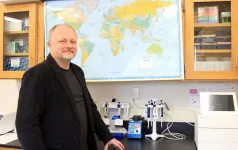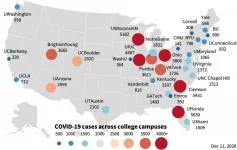(Press-News.org) A remarkable prediction of Einstein's theory of general relativity--the theory that connects space, time, and gravity--is that rotating black holes have enormous amounts of energy available to be tapped.
For the last 50 years, scientists have tried to come up with methods to unleash this power. Nobel physicist Roger Penrose theorized that a particle disintegration could draw energy from a black hole; Stephen Hawking proposed that black holes could release energy through quantum mechanical emission; while Roger Blandford and Roman Znajek suggested electromagnetic torque as a main agent of energy extraction.
Now, in a study published in the journal Physical Review D, physicists Luca Comisso from Columbia University and Felipe Asenjo from Universidad Adolfo Ibanez in Chile, found a new way to extract energy from black holes by breaking and rejoining magnetic field lines near the event horizon, the point from which nothing, not even light, can escape the black hole's gravitational pull.
"Black holes are commonly surrounded by a hot 'soup' of plasma particles that carry a magnetic field," said Luca Comisso, research scientist at Columbia University and first author on the study.
"Our theory shows that when magnetic field lines disconnect and reconnect, in just the right way, they can accelerate plasma particles to negative energies and large amounts of black hole energy can be extracted."
This finding could allow astronomers to better estimate the spin of black holes, drive black hole energy emissions, and might even provide a source of energy for the needs of an advanced civilization, Comisso said.
Comisso and Asenjo built their theory on the premise that reconnecting magnetic fields accelerates plasma particles in two different directions. One plasma flow is pushed against the black hole's spin, while the other is propelled in the spin's direction and can escape the clutches of the black hole, which releases power if the plasma swallowed by the black hole has negative energy.
"It is like a person could lose weight by eating candy with negative calories," said Comisso, who explained that essentially a black hole loses energy by eating negative-energy particles. "This might sound weird," he said, "but it can happen in a region called the ergosphere, where the spacetime continuum rotates so fast that every object spins in the same direction as the black hole."
Inside the ergosphere, magnetic reconnection is so extreme that the plasma particles are accelerated to velocities approaching the speed of light.
Asenjo, professor of physics at the Universidad Adolfo Ibáñez and coauthor on the study, explained that the high relative velocity between captured and escaping plasma streams is what allows the proposed process to extract massive amounts of energy from the black hole.
"We calculated that the process of plasma energization can reach an efficiency of 150 percent, much higher than any power plant operating on Earth," Asenjo said. "Achieving an efficiency greater than 100 percent is possible because black holes leak energy, which is given away for free to the plasma escaping from the black hole."
The process of energy extraction envisioned by Comisso and Asenjo might be already operating in a large number of black holes. That may be what is driving black hole flares--powerful bursts of radiation that can be detected from Earth.
"Our increased knowledge of how magnetic reconnection occurs in the vicinity of the black hole might be crucial for guiding our interpretation of current and future telescope observations of black holes, such as the ones by the Event Horizon Telescope," Asenjo said.
While it may sound like the stuff of science fiction, mining energy from black holes could be the answer to our future power needs.
"Thousands or millions of years from now, humanity might be able to survive around a black hole without harnessing energy from stars," Comisso said. "It is essentially a technological problem. If we look at the physics, there is nothing that prevents it."
The study, Magnetic reconnection as a mechanism for energy extraction from rotating black holes, was funded by the National Science Foundation's Windows on the Universe initiative, NASA, and Chile's National Fund for Scientific and Technological Development.
Vyacheslav (Slava) Lukin, a program director at NSF, said the Foundation aims to catalyzes new theoretical efforts based on frontier observations at facilities such as the EHT, bringing together theoretical physics and observational astronomy under one roof.
"We look forward to the potential translation of seemingly esoteric studies of black hole astrophysics into the practical realm," Lukin said.
"The ideas and concepts discussed in this work are truly fascinating," said Vyacheslav (Slava) Lukin, a program director at the National Science Foundation. He said NSF aims to catalyze new theoretical efforts based on frontier observations, bringing together theoretical physics and observational astronomy under one roof.
"We look forward to the potential translation of seemingly esoteric studies of black hole astrophysics into the practical realm," he added.
INFORMATION:
Irvine, Calif., Jan. 11, 2021 - Often admired for their flawless appearance to the naked eye, crystals can have defects at the nanometer scale, and these imperfections may affect the thermal and heat transport properties of crystalline materials used in a variety of high-technology devices.
Employing newly developed electron microscopy techniques, researchers at the University of California, Irvine and other institutions have, for the first time, measured the spectra of phonons - quantum mechanical vibrations in a lattice - at individual crystalline faults, and they discovered the propagation of phonons near the flaws. The team's findings are the subject of a study published recently in Nature.
"Point defects, dislocations, stacking ...
Irvine, Calif., Jan. 5, 2021 -- Scientists at the University of California, Irvine have developed a new deep-learning framework that predicts gene regulation at the single-cell level.
Deep learning, a family of machine-learning methods based on artificial neural networks, has revolutionized applications such as image interpretation, natural language processing and autonomous driving. In a study published recently in Science Advances, UCI researchers describe how the technique can also be successfully used to observe gene regulation at the cellular level. Until now, that process had ...
A pioneering study by University of Bristol researchers finds that the evolution of teeth in the giant prehistoric shark Megalodon and its relatives was a by-product of becoming huge, rather than an adaptation to new feeding habits.
The iconic extinct Megalodon was the largest shark to ever roam the seas. Its name translates to 'big tooth', making reference to its massive teeth, which represent the most abundant fossil remains of the species. They are broad and triangular, nothing like the curved, blade-like teeth of the closest relatives of Megalodon.
The ...
DURHAM, N.C. - Glioblastoma brain tumors are especially perplexing. Inevitably lethal, the tumors occasionally respond to new immunotherapies after they've grown back, enabling up to 20% of patients to live well beyond predicted survival times.
What causes this effect has long been the pursuit of researchers hoping to harness immunotherapies to extend more lives.
New insights from a team led by Duke's Preston Robert Tisch Brain Tumor Center provide potential answers. The team found that recurring glioblastoma tumors with very few mutations are far more vulnerable ...
Even with the COVID-19-related small dip in global carbon emissions due to limited travel and other activities, the ocean temperatures continued a trend of breaking records in 2020. A new study, authored by 20 scientists from 13 institutes around the world, reported the highest ocean temperatures since 1955 from surface level to a depth of 2,000 meters.
The report was published on January 13 in Advances in Atmospheric Sciences and concluded with a plea to the policymakers and others to consider the lasting damage warmer oceans can cause as they attempt to mitigate the ...
Today, the largest study of genetic diversity in Ukraine was published in the open science journal GigaScience. The project was an international effort, bringing together researchers in Ukraine, the US and China and is the first fruits of this collaboration to set up a new Central Europe Center for Genomic Research in Ukraine. Led by researchers at Uzhhorod National University and Oakland University in the US, the work provides genetic understanding of the historic and pre-historic migration settlements in one of the key intersections of human trade and migration between the Eurasian peoples as well as the identification of genetic variants of medical interest in the Ukrainian population that differ ...
College campuses are at risk of becoming COVID-19 superspreaders for their entire county, according to a new vast study which shows the striking danger of the first two weeks of school in particular.
Looking at 30 campuses across the nation with the highest amount of reported cases, experts saw that over half of the institutions had spikes - at their peak - which were well above 1,000 coronavirus cases per 100,000 people per week within the first two weeks of class.
In some colleges, one in five students had been infected with the virus by the end of the fall term. Four institutions had over 5,000 ...
A detailed description of how ovarian cancer cells adapt to survive and proliferate in the peritoneal cavity has been published in Frontiers in Oncology. Researchers show that structures inside the cells change as the disease progresses from benign to malignant, helping the cells to grow in an otherwise hostile environment of low nutrients and oxygen. Understanding how these cellular adaptations are regulated could herald new targeted treatment options against the fifth-leading cause of cancer-related deaths in women.
"Our study compared the structures inside cells representing different stages of ovarian cancer, including after aggregation, which enhances their survival," says Eva Schmelz, a Professor and Scientific Director at Virginia Tech University, USA, who led this research. "We found ...
The remote learning experience of parents who had their children at home in Spring 2020, as schools across the US closed during the United States' COVID-19 lockdown, was more positive than widely believed.
That is the suggestion from a new study published in the Journal of School Choice, which looked at the experience of a nationally representative sample of 1,700 parents stretching right across America.
On average only 44% of parents reported the online learning program required too much of parents, while 38% of parents said it was difficult for them to manage the online provisions.
However, worryingly, most parents (63%) believed remote learning caused their child to fall behind.
While the study focused ...
Yale researchers have devised a way to peer into the brains of two people simultaneously while are engaged in discussion. What they found will not surprise anyone who has found themselves arguing about politics or social issues.
When two people agree, their brains exhibit a calm synchronicity of activity focused on sensory areas of the brain. When they disagree, however, many other regions of the brain involved in higher cognitive functions become mobilized as each individual combats the other's argument, a Yale-led research team reports Jan. 13 in the journal Frontiers of Human Neuroscience.
"Our entire brain ...



